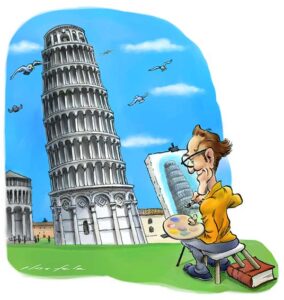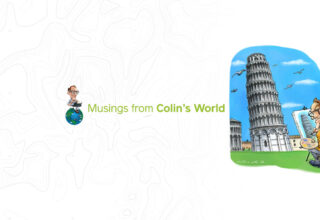Throughout the modern age of tourism, tour operators have built most tours around Rome, Florence and Venice, and there are good reasons for that. Those three cities have thousands of years of rich culture and history packed into tight clusters. The Big Three were independent city states of major importance for many centuries before Italy was established as a nation in 1861. Each has its own independent history and culture. As three separate nations historically, they still have separate, individual characters.
According to legend, Rome was founded in 753 B.C. Roman historian Marcus Terentius Varro set the date as the first century BC, but archaeological findings date the human settlement as far back as 14,000 years. Rome was the foundation of what became Europe. Its importance and cultural richness cannot be overstated.
Venice was founded in 697 as a republic, and was the world’s first international financial center. It has always held a unique place among all of the cities in the world because its main arteries of transportation are on water, not land. And that’s only the beginning of what there is to experience there.
 Florence was founded in 1115, also as an independent republic; archaeological traces of human habitation there date back 2,000 years. The Florentine dialect was the basis of the modern Italian language – and Florence was the home of the Renaissance, from which modern Europe sprung.
Florence was founded in 1115, also as an independent republic; archaeological traces of human habitation there date back 2,000 years. The Florentine dialect was the basis of the modern Italian language – and Florence was the home of the Renaissance, from which modern Europe sprung.
There is no end to what can be seen and experienced in the Big Three. I could go back to any of them over and over and I would never get tired of them. You could never begin to exhaust the possibilities. And the pleasure of just being there in any of them is always fresh and renewed.
Tours of the Big Three offered by various tour operators are all different, because each tour operator selects different things to experience in each place, and there is no end to the possibilities. Each tour is also unique in how it structures the routes and the stops along the way between those cities, choosing from unlimited possibilities of what to see and do there.
But there are also good reasons for traveling beyond those centers. One is to go beyond the most heavily touristed areas where the crowds are. But the main reason is just to get out there and experience more of the tremendous richness that Italy has to offer throughout the peninsula. There is a world beyond the Big Three, much more than can even be touched on in one article. But here are a few selected possibilities:
Verona. “Two households, both alike in dignity, In fair Verona, where we lay our scene,” wrote William Shakespeare, as he began the tragedy of Romeo and Juliet. In Verona there is a balcony that inspired the famous balcony scene. Shakespeare’s play was based on earlier versions of the same story from as far back as Dante. There may well have been a real Romeo and Juliet at some point. Who knows? In any case, the spirit of Romeo and Juliet lives in Verona, making it stand out as a very romantic destination, even in Italy, which has a reputation as the most romantic destination of all. Shakespeare must have loved Verona, though he may not have ever been there. He also set his play Two Gentlemen of Verona there.
Verona has one of the most well-preserved Roman arenas in the world, though Verona had already been a city for hundreds of years when it became part of the Roman Empire. Verona is also worth visiting if only for its own fine version of Northern Italian cuisine.
The Amalfi Coast, or Costiera Amalfitana in the native tongue, is a 30-mile strip on the southern coast of the Sorrento Peninsula on the Gulf of Salerno. It’s a scene of staggering natural beauty, where giant cliffs jut out of the ocean, and houses and terraces are built intricately into the steep landscapes overlooking the sea. Every possible view of the place is spectacular, whether from the water below or from the shore road above. From there you can take a boat excursion to the legendary Isle of Capri.
Pisa is a place almost everyone knows because of the famous Leaning Tower, where Galileo tested his theory of gravity. But Pisa also has a history that dates back to Etruscan relics from the fifth century BC. Later it was a major Roman port. There are many castles and churches that mark Pisa’s succeeding eras, including the Cathedral of Santa Maria Assunta and Campo Santo.
Pompeii. Who can resist the story of Pompeii, where the volcano of Vesuvius erupted in 79 A.D, and buried the city in ash? The sudden incineration of Pompeii petrified the city life, freezing it in its last moment of existence, preserving it as a glimpse of life across a span of 2,000 years, leaving art, jewelry and other relics intact. Seeing this is a unique experience, never to be forgotten.
Milan. Italy’s claim as the capital of style is hard to refute, and Milan is the center of Italian style. It is northern Italy’s center of culture and commerce and attracts visitors for many reasons: the Grand Prix Monza; Milano Film Festival; Opera season from December to July; the spectacular Cathedral or Duomo of Milan and the Duomo Museum; and the Church of St. Gottardo in Corte from the 14th century. As Italy’s fashion capital, it’s also a great shopping destination.
Epicurean pleasures alone justify the trip. Milan’s rich culinary heritage brings its own style to northern Italian cuisine, with its own Milanese flavors and accents, distinct from the better-known Mediterranean cuisine farther down peninsula.
Bologna. Bologna is the seventh most populous city of Italy with a rich history going back to its origins as an Etruscan city, later as a Celtic settlement, and then a Roman city. Traces of human habitation date back to the third century BC, and the gorgeous Bolognese landscape was fought over by many tribes and nations since the dawn of history. Anyone who has enjoyed Bolognese style spaghetti can appreciate Bologna’s ancient culinary tradition from the Middle Ages. Having lunch in a traditional tavern in Bologna is a great way to experience them.
Lake Como. Up in the north, where Italy starts to blend in with the mountains of Switzerland, is the serenely beautiful Lake Como, and the town of Como, between the lake and the mountains. Enchanting villas and colorful gardens are set into the breathtaking lakeside landscape. Como is also a major cultural and historical landmark, with museums such as the Archaeological Museum, Museo Storico Giuseppe Garibaldi and Pinacoteca Civica. But the best way to experience Como is on the streets of Como, where you can take in great architectural treasures and the pulsating street life of the living city, with its restaurants, shops and cafes.
Naples. Naples, the third largest city in Italy after Rome and Milan, stands in the shadows of Mount Vesuvius on Italy’s west coast overlooking the Tyrrhenian Sea. The city has been inhabited since the Neolithic period. Today, it’s a dynamic coastal urban center that offers a multitude of culinary treasures and thrilling nightlife. You can climb Mount Vesuvius or attend a wine tasting on the slopes, visit the Naples National Archaeological Museum, the San Gennaro Catacombs and the ruins of Herculaneum.
In Italy there is no end to the fascinating places to experience. It’s continuous. No listing could be completed, only abandoned. My next list would start with Puglia. And while in Italy, how about checking out Sicily? The landscapes of Italy provide endless treasures for the traveler. So much of the world is wrapped up in one small peninsula, which was the original center of western civilization, and in many ways still is.
Your humble reporter,
Colin Treadwell

